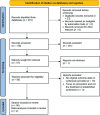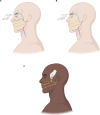Approaches to the Management of Synkinesis: A Scoping Review
- PMID: 38604247
- PMCID: PMC11259496
- DOI: 10.1055/a-2305-2007
Approaches to the Management of Synkinesis: A Scoping Review
Abstract
Postparalysis facial synkinesis (PPFS) can develop in any facial palsy and is associated with significant functional and psychosocial consequences for affected patients. While the prevention of synkinesis especially after Bell's palsy has been well examined, much less evidence exists regarding the management of patients with already established synkinesis. Therefore, the purpose of this review is to summarize the available literature and to provide an overview of the current therapeutic options for facial palsy patients with established synkinesis. A systematic literature review was undertaken, following the Preferred Reporting Items of Systematic Reviews and Meta-analyses 2020 guidelines. MEDLINE via PubMed and Cochrane Library were searched using the following strategy: ([facial palsy] OR [facial paralysis] OR [facial paresis]) AND (synkinesis) AND ([management] OR [guidelines] OR [treatment]). The initial search yielded 201 articles of which 36 original papers and 2 meta-analyses met the criteria for inclusion. Overall, the included articles provided original outcome data on 1,408 patients. Articles were divided into the following treatment categories: chemodenervation (12 studies, 536 patients), facial therapy (5 studies, 206 patients), surgical (10 studies, 389 patients), and combination therapy (9 studies, 278 patients). Results are analyzed and discussed accordingly. Significant heterogeneity in study population and design, lack of control groups, differences in postoperative follow-up, as well as the use of a variety of subjective and objective assessment tools to quantify synkinesis prevent direct comparison between treatment modalities. To date, there is no consensus on how PPFS is best treated. The lack of comparative studies and standardized outcome reporting hinder our understanding of this complex condition. Until higher quality scientific evidence is available, it remains a challenge best approached in an interdisciplinary team. An individualized multimodal therapeutic concept consisting of facial therapy, chemodenervation, and surgery should be tailored to meet the specific needs of the patient.
The Author(s). This is an open access article published by Thieme under the terms of the Creative Commons Attribution-NonDerivative-NonCommercial License, permitting copying and reproduction so long as the original work is given appropriate credit. Contents may not be used for commercial purposes, or adapted, remixed, transformed or built upon. (https://creativecommons.org/licenses/by-nc-nd/4.0/).
Conflict of interest statement
None declared.
Figures



Similar articles
-
Too much or too little? A systematic review of postparetic synkinesis treatment.J Plast Reconstr Aesthet Surg. 2020 Mar;73(3):443-452. doi: 10.1016/j.bjps.2019.10.006. Epub 2019 Oct 11. J Plast Reconstr Aesthet Surg. 2020. PMID: 31786138 Free PMC article.
-
Facial synkinesis: A distressing sequela of facial palsy.Ear Nose Throat J. 2024 Jun;103(6):NP382-NP391. doi: 10.1177/01455613211054627. Epub 2021 Nov 26. Ear Nose Throat J. 2024. PMID: 34836457 Review.
-
Neuromuscular retraining therapy for early stage severe Bell's palsy patients minimizes facial synkinesis.Clin Rehabil. 2023 Nov;37(11):1510-1520. doi: 10.1177/02692155231166216. Epub 2023 Mar 27. Clin Rehabil. 2023. PMID: 36972474
-
Selective Neurectomy for Treatment of Post-Facial Paralysis Synkinesis: A Systematic Review.Facial Plast Surg. 2023 Apr;39(2):190-200. doi: 10.1055/a-1950-4483. Epub 2022 Sep 25. Facial Plast Surg. 2023. PMID: 36155895
-
A General Approach to Facial Palsy.Otolaryngol Clin North Am. 2018 Dec;51(6):1019-1031. doi: 10.1016/j.otc.2018.07.002. Epub 2018 Aug 16. Otolaryngol Clin North Am. 2018. PMID: 30119926 Review.
Cited by
-
Single versus dual innervation in facial palsy reanimation with free functional muscle transfers: a systematic review and meta-analysis.JPRAS Open. 2025 Jun 19;45:239-250. doi: 10.1016/j.jpra.2025.06.009. eCollection 2025 Sep. JPRAS Open. 2025. PMID: 40809536 Free PMC article. Review.
-
Risk Factors Associated With Bell's Palsy: A Real-World Analysis of 281,600 Patients.Eur J Neurol. 2025 Aug;32(8):e70336. doi: 10.1111/ene.70336. Eur J Neurol. 2025. PMID: 40838411 Free PMC article.
References
-
- Montserrat L, Benito M. Facial synkinesis and aberrant regeneration of facial nerve. Adv Neurol. 1988;49:211–224. - PubMed
-
- Crumley R L. Mechanisms of synkinesis. Laryngoscope. 1979;89(11):1847–1854. - PubMed
-
- van Veen M M, Quatela O, Tavares-Brito J et al.Patient-perceived severity of synkinesis reduces quality of life in facial palsy: a cross-sectional analysis in 92 patients. Clin Otolaryngol. 2019;44(03):483–486. - PubMed
Publication types
MeSH terms
LinkOut - more resources
Full Text Sources
Miscellaneous

